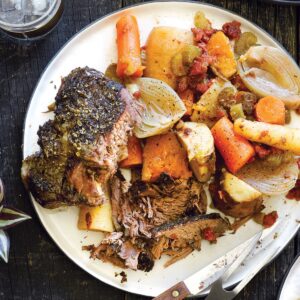
Healthy Food Guide founding editor Niki Bezzant looks back at the year to find out what the biggest food trends were and how the events of 2020 changed our relationship with food.
How our eating changed in 2020
It’s been quite a year. And while we’re all looking forward to moving on from 2020, we probably have a bit of trepidation as well – who knows what 2021 will bring? There’s no doubt our lives have all changed for good.
One of the interesting ways lives have changed is in the kitchen. Around the world, shopping and eating habits have changed; what we buy, how we cook and how we eat out are all different from how they were a year ago. Here are a few of the ways our food habits have changed.
Homeward bound
Depending on where you are in the world, living life in and out of various levels of lockdown and working from home means spending a lot more time inside our own four walls. In New Zealand, during the national lockdown in March and April, every one of us was forced to cook and eat every single meal at home.
That meant huge volumes of every kind of food being sold in supermarkets. Countdown Supermarkets had its biggest ever day of selling produce on Thursday 9th April, with volumes 20 per cent larger than Christmas. That included 87,000 heads of broccoli; 80,000 kilos of bananas; 80,000 avocados and 65,000 bags of potatoes.
While we’re back to eating takeaway and restaurant meals, we’re still cooking at home and stocking up at the supermarket, tending to buy larger packs and keep the supplies on hand in the pantry and freezer.
A recent survey of 5000 European consumers found a third said it would be important to have time to make home-cooked meals after the pandemic.
But it’s getting old for US consumers; a survey there found 65 per cent say they’re tired of cooking at home.
Baking up a storm
Remember when you couldn’t scroll social media without seeing several sourdoughs and bulk banana bread? That wasn’t just you; it was a global trend. Everyone got back into the kitchen to flex their baking skills.
Neilsen supermarket sales data revealed sales of products in the ‘scratch cooking and baking’ category shot up in April with flour showing dollar growth of 113 per cent compared with April 2019. Countdown says it sold 1.25 million kilos of flour in March and April – roughly enough to make a large pizza for every Kiwi or 2.5 million lots of playdough.
Articles about bread baking spread like a sourdough starter and appeared everywhere from the Wall Street Journal to the local paper. There’s even an academic paper on the sourdough bread trend, in which author Gwyn Easterbrook-Smith has this to say: “Baking bread during isolation is an activity whose purposes are threefold: providing sustenance; filling newly available leisure time; and offering a way to demonstrate one’s skill and activities on social media”. After all, what’s the bread without the online glory?
Serious comfort eating
What do you eat when you can’t have takeaways? ‘Fakeaways’ – homemade takeaways that attempt to mimic the real thing. If you weren’t making your own pizza, burgers or fish and chips, you were probably buying a coffee machine and re-creating that café flat white or latte, with sales of coffee and coffee pods shooting up.
To go with that coffee? As well as home-baked treats, we bought more ready-made ones too. Nielsen supermarket data showed big increases during lockdown in ‘indulgence’ desserts like jellies, rice puddings and microwavable desserts – which went up by 57 per cent. Ice cream sales increased 29 per cent and snack foods were up 23 per cent.
In the Covid Kai survey, which tracked Kiwis’ shopping and eating habits during lockdown, two out of five surveyed said they were eating more sweet snacks, and overall snacking activity was up.
Shopping online and local
If you weren’t an online shopper pre-pandemic, chances are you are one now. Online shopping has increased around the world, and many of us, now we’ve got into the habit, report we’ll keep on doing it.
Local fare has become more popular, too, not just ingredients but venues. Local suburban neighbourhood cafes and eateries have exploded in popularity with more of us continuing to work from home and spending time in our own hood; this trend is set to continue, according to the Restaurant Association.
We’re thinking about health and immunity
Almost half of European consumers say being in good health is more important to them as a result of COVID-19.
One food industry survey found 80 per cent of consumers say they now plan to eat and drink more healthily, while one-third of consumers are purchasing more items tailored to their health.
It’s a trend playing out on shop shelves around the world; claims about health properties and immunity are trending everywhere, and we can expect this to continue.
As is often the case when it comes to our health, and in the immortal words of Joni Mitchell: we don’t know what we’ve got till it’s gone.
Article sources and references
- Sarah Gerritsen, et al. Seven weeks of home-cooked meals: changes to New Zealanders’ grocery shopping, cooking and eating during the COVID-19 lockdown, Journal of the Royal Society of New Zealand, DOI: 10.1080/03036758.2020.1841010https://www.tandfonline.com/doi/full/10.1080/03036758.2020.1841010
- Health trumps price among COVID-hit consumers, report reveals. Food Navigator, accessed December 2020https://www.foodnavigator.com/Article/2020/12/02/Health-trumps-price-among-COVID-hit-consumers-report-reveals
- How the pandemic is shaping home cooking trends. Smart Brief, access December 2020https://www.smartbrief.com/original/2020/09/how-pandemic-shaping-home-cooking-trends
- 2021: A Year For Proactive, Holistic Nourishment. Food Navigator, accessed December 2020https://www.foodnavigator.com/News/Promotional-Features/2021-A-Year-For-Proactive-Holistic-Nourishment
- Gwyn Easterbrook-Smith (2020) By Bread Alone: Baking as Leisure, Performance, Sustenance, During the COVID-19 Crisis, Leisure Sciences, DOI: 10.1080/01490400.2020.1773980https://www.tandfonline.com/doi/full/10.1080/01490400.2020.1773980?scroll=top&needAccess=true
- Booze, baking and biking in our bubbles: Studies reveal Kiwis' health during lockdown. Stuff, accessed December 2020https://www.stuff.co.nz/national/health/coronavirus/300035805/booze-baking-and-biking-in-our-bubbles-studies-reveal-kiwis-health-during-lockdown
www.healthyfood.com










